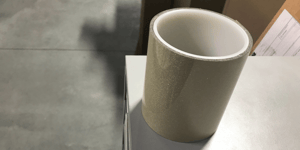Electrically conductive transfer tape has been used for years to avoid causing messes with thermal glue.
It should NOT be mistaken for ELECTRICAL tape, which is an insulator.
But what is ECTT, and why do people use it? Let's get down to the bottom of this.
What is Electrically Conductive Transfer Tape (ECTT)?
Electrically conductive transfer tape, or ECTT, is made of a fabric base often coated in epoxy, silicone, or polyamide resin.
ECTT's resin coat is often full of conductive fillers that have either been interspliced with fabric fibers or combined with the adhesive. It experiences electrical conduction in the Z-axis, meaning electricity is transmitted through their thickness rather than only the X or Y planes.
Electrically conductive fillers remain close enough in contact with one another to carry electric signals through the adhesive. The particles themselves can be flakes of gold, nickel, copper, carbon (such as graphite), or silver, which is the most common due to cost.
The fillers' amount and size determine the strength of the tape's conductivity (more fillers = higher conductivity).
-1.png?width=2048&name=Untitled%20design%20(1)-1.png)
ECTT Applications
Electrically conductive transfer tapes have many applications and are used in various industries, including medical, aviation, automotive, and consumer products.
However, they're most recognized for their application in printed circuit boards.
Electrically conductive transfer tape is perfect for mounting small components onto printed circuit boards and holding them in place without disrupting the electrical flow.
Electrically conductive transfer tape can fill the gap between the lid and the body of a device and seal it while maintaining a connection.
Electrically conductive transfer tapes are often very flexible and versatile adhesives, ideal for electromedical devices, conductive gaskets, thermistor resistors, computer chips, solar cell fabricating, or consoles.
One advantage of ECTT flexibility is building practical, wearable electronics, also known as 'wearables,' whose global reputation these past few years has expanded dramatically.
ECTT can be wrapped around electrical wires, protecting them while imitating the same conductive ability. Also, while most electrically conductive transfer tape is made of vinyl, it CAN be plastic, yet it lacks the same protective capabilities.
Indeed, the strangest application of ECTT is to repel slugs when gardening. The gardener places copper adhesive tape around their plants or plot of land, and when slugs crawl over the tape, their slime reacts with the metal to produce a startling shock.
Whether to build a circuit board or handle a slug infestation, custom die cut electrically conductive transfer tape might be the key to assembling your next project.
If you're interested in a collaboration, tell us more about what you're doing and what your thoughts are.
Now onto the final part.
Selecting an Electrically Conductive Transfer Tape
Many different types of adhesive fall under electrically conductive transfer tape classification.
First and foremost, the right ECTT should suit the needs of your project and does so through various factors.
ELECTROMAGNETIC (EMI) SHIELDING
If a workspace has a high level of electromagnetic interference, you may consider applying an adhesive with strong resistance abilities.
Sensitive machinery is less likely to malfunction if there are safeguards in place to prevent anomalies from having catastrophic effects. This is especially relevant in hospitals, where the slightest change can mean the difference between life and death.
THERMAL SHIELDING
Electrically conductive transfer tape does more than transfer electricity; thermal shielding is the perfect example.
Electrons and electricity are mediated by electrons, meaning most ECTT materials also function as effective heat conductors.
In the competitive struggle to prevent devices from overheating, it's necessary for small parts, such as circuit boards, to come with adequate heat sinks already built in.
Electrically conductive transfer tape can apportion warmth and prevent overheating.
STATIC CHARGE (ESD) REDUCTION
ECTT materials are often chosen with the intent to reduce static charges by absorbing most of the electrostatic discharge that flows through.
The difficulty here is ensuring that the device retains its initial speed and performance while minimizing any power leakage.
There are a few more factors to consider when choosing the right tape:
- Automation
- Speed of the bond
- Environmental conditions
- Transportation conditions/Storage
- Timeframe
Factors such as temperature or humidity can ruin the entire functionality of an electrically conductive transfer tape by causing the conductivity of an adhesive to fail.
Understanding the situation where you plan on using your electrically conductive transfer tape will enable you to decide which tape is the right choice for your project.
True converters don't shy away from legwork. If you're sketching out a project, even if you're still working out the kinks, let us know your concerns, and we'd be happy to help figure out your next move.





